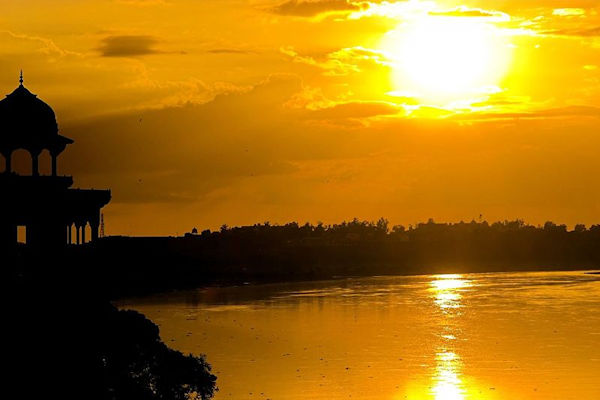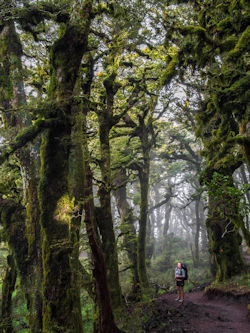SEJournal Online is the digital news magazine of the Society of Environmental Journalists. Learn more about SEJournal Online, including submission, subscription and advertising information.
 |
| India’s Yamuna River, above, is one of a number of natural entities that have been granted rights or personhood. Photo: melenama, Creative Commons (CC BY-SA 2.0). |
Feature: How ‘Rights of Nature’ Is Recasting the Relationship Between Law and the Earth
By Alice Bleby
Calls to reconsider humanity’s relationship with nature are not new, but perhaps they are more urgent now than ever before. Faced with the double catastrophes of climate change and global biodiversity loss, and ecological degradation that threatens the viability of the Earth system, momentum is building for a radical rethink of how law conceives of — and ultimately sanctions the destruction of — the environment.
For tens of thousands of years, Indigenous peoples have modeled a relationship with the Earth premised on interconnection with nature and respect for the inherent worth of the environment.
Much more recently, ecological philosophers in the Western tradition have argued that the dominance of Cartesian dualism, which creates a schism between “rational” humans and physical nature, and upon which Western science, culture, economics and law are predicated, must be superseded by an ethical and moral code that recognizes nature’s intrinsic value. (Roderick Nash’s 1989 book “The Rights of Nature: A History of Environmental Ethics” provides a good summary of these lines of thought.)
Legal rights for nature or natural entities are emerging as one way to translate this philosophical paradigm shift into real changes in how society treats nature.
After a slow start, momentum is growing
Although Christopher Stone published his seminal article “Should Trees Have Standing?” in 1972, the first formal rights of nature instrument was not enacted until more than 30 years later.
In 2006, in response to a proposed dumping of sewage sludge that threatened the health of human and natural communities in Tamaqua Borough in Pennsylvania, the local council passed an ordinance acknowledging nature’s rights.
Examples of these laws continue to proliferate,
from Bangladesh to Uganda, and in many local
government jurisdictions in the United States.
In 2008, rights of nature were incorporated into the new constitution of the Republic of Ecuador (Articles 71-74), followed by legislative recognition in Bolivia in 2010. Legislation recognizing the legal personhood of natural entities was enacted in Aotearoa New Zealand in 2014 and 2017, and courts have recognized the legal rights of rivers in Colombia and India.
Examples of these laws continue to proliferate, from Bangladesh to Uganda, and in many local government jurisdictions in the United States.
Wide range of cultural, legal contexts
Legal frameworks for nature’s rights and representation in law are developing in diverse cultural and jurisprudential contexts.
Many nature rights instruments, particularly in the United States, have been enacted in response to an imminent threat, such as sludge dumping in Tamaqua or, commonly, fracking.
Residents finding themselves unable to protect their community and local environment using conventional environmental law have enacted ordinances recognizing the rights of nature and prohibiting breaches of those rights by individuals and corporations under municipal law.
A recent example that made international headlines is the Lake Erie Bill of Rights. Following a water crisis in 2014, when Toledo, Ohio, was left without drinking water for three days due to toxic algal blooms in Lake Erie, a group of local residents campaigned for the introduction of a local law that recognized the rights of Lake Erie to exist, flourish and naturally evolve.
Although the bill of rights won community support, it was ruled invalid by a court in 2020.
Rights of nature laws have also been enacted by communities aspiring to the highest levels of sustainability. In Santa Monica, California, for instance, a sustainability rights ordinance was enacted by a council well known for its progressive stance on environmental issues.
Agency, autonomy, inherent worth
There are other catalysts for these types of laws, too.
 |
| The forested area of Te Urewera was recognized as a legal person in settling historical claims of Māori tribes in New Zealand. Photo: Elemental_Adventure, Creative Commons (CC BY-ND-NC 2.0 JP). |
In Aotearoa New Zealand, legislation recognizing Te Urewera (a forested area that was formerly a national park) and the Whanganui River as legal persons was enacted in the context of the settlement of historical claims of Tūhoe and the Whanganui iwi (Māori tribe) under the Treaty of Waitangi.
Legal personhood (including the transfer of land title to the newly recognized legal entity), and the recognition of fundamental values and principles in legislation, is a way to acknowledge the relationship of iwi with these natural entities through a western legal mechanism that is typically unable to account for nature.
These laws pose a radical challenge to Western legal systems, because they characterize nature as a legal subject.
Traditionally, the environment and all its component parts have been legally considered to be property, able to be used and transferred (and even destroyed) by its legal owner.
Conventional environmental law places some limits on how owners of environmental property and third parties may deal with nature, but these are hard-won and limited restraints on an otherwise large freedom to exercise dominion and claim property rights over nature.
In contrast, legal subjecthood presupposes legal agency, autonomy and inherent worth — and the capacity to exercise legal rights.
Multiple ways of recognizing rights for nature
Reflecting their diverse origins and legal contexts, laws that recognize nature as a legal subject do so in different ways.
One of the most obvious differences is between laws that recognize specific, enumerated rights for nature, and those that recognize nature as a “legal person.”
The rights recognized in the former type of law usually include the right to life, the right to regenerate and the right to evolve. Some instruments also include a right to be restored.
Alternatively, laws that recognize legal personhood for nature — in a similar way as a corporation is considered a legal person — may not include any such specific rights. Legal personhood is widely understood to attract legal rights to sue and be sued, to enter into contracts and to own property (hence, the Whanganui River in Aotearoa is the titleholder of its own land).
There are also variations in the way nature, as the rights holder or legal person, is conceived of by these laws.
Some recognize rights for nature as a whole, in general terms. This is the approach of the Ecuadorian Constitution, for example.
Some instruments are slightly more specific: Santa Monica’s sustainability code defines the “natural communities and ecosystems” that hold rights as “groundwater aquifers, atmospheric systems, marine waters, and native species within the boundaries of the City.”
Other laws grant rights or personhood to a specific natural entity — rivers are a common example of this, including the Whanganui River, the Atrato River in Colombia, all rivers in Bangladesh and the Ganges and Yamuna Rivers in India.
This was also the approach adopted by the Lake Erie Bill of Rights, which singled out the lake and its watershed as the rights holder.
And this approach has also been extended to a plant species, in the Rights of Manoomin Resolutions enacted by the White Earth Band of Ojibwe and 1855 Treaty Authority to protect the rights of wild rice.
Who should speak — and act — on nature’s behalf?
Another feature of these laws that plays an important role in their implementation relates to who may speak and act on nature’s behalf.
Representative arrangements for legal subjects who are not able to represent themselves are common — consider guardianship arrangements for children, or representatives empowered to speak on behalf of a company.
Some rights of nature laws provide for designated “guardians” or legal representatives of nature. For example, the Te Awa Tupua (Whanganui River Claims Settlement) Act establishes Te Pou Tupua, a joint role held by two people who are the “human face” of the river, and are mandated “to act and speak for and on behalf of Te Awa Tupua” (sections 18 and 19).
Court decisions in India have designated certain persons or, in the case of the animal kingdom, all citizens to be guardians in loco parentis for natural entities, but this role has not been comprehensively developed in law to date.
The Lake Erie Bill of Rights provided that
the lake itself may bring an action to enforce
its rights, with the City of Toledo or
residents acting on its behalf.
Alternatively, some instruments grant universal standing to all citizens or all residents of the relevant municipality to enforce and defend nature’s rights. For example, the Lake Erie Bill of Rights provided that the lake itself may bring an action to enforce its rights, with the City of Toledo or residents acting on its behalf.
Although the difference between bringing a lawsuit in the name of residents or in the name of nature itself may seem like semantics, it has powerful symbolic significance in court systems that have traditionally conceived of nature as a legal object without agency or interests.
Many questions, an urgent need for answers
While the construction and implementation of rights of nature laws are unique to their context, there is a common theme reflected in their emergence in diverse jurisdictions around the world: Conventional environmental law is unable to protect the Earth from the rapacity of human civilizations, and new legal and political strategies are urgently needed.
Of course, many important questions remain about these laws: For example, what is the role of Indigenous people in developing and implementing these laws, and in the rights of nature movement more broadly? How is the implementation of these laws progressing, and what adjustments need to be made to make them more effective? How do rights of nature laws on a local and national level translate into a response to the planetary crisis we are facing?
All of these questions, and many more, deserve attention from communities, advocates, lawyers, scholars and journalists.
As we face the onset of the Anthropocene, it is vital that we develop, test and improve new ways of protecting the Earth through our legal system and more broadly. One way to do this is to accord nature her rightful place, and her rights, in law.
Further Reading and Resources
Articles and books
- “Rights of Nature As a Response to the Anthropocene,” Alice Bleby, University of Western Australia Law Review, 2020
- “The Rights of Nature Movement in the United States: Community Organizing, Local Legislation, Court Challenges, Possible Lessons and Pathways,” Marsha Moutrie, Environmental and Earth Law Journal, 2021
- “The Rights of Nature: A Legal Revolution That Could Save the World,” David R. Boyd, ECW Press, 2017
- “Should Trees Have Standing?: Law, Morality, and the Environment,” Christopher D. Stone, Oxford University Press, 2010
Organizations
- Community Environmental Legal Defense Fund
- Earth Law Center
- Movement Rights
- Global Alliance for the Rights of Nature
Alice Bleby is a Scientia PhD candidate at the University of New South Wales (Sydney, Australia) researching legal subjecthood for nature. Her research includes an empirical study of laws recognizing nature as a legal subject in the United States (Santa Monica, California, and Toledo, Ohio) and Aotearoa New Zealand. Bleby holds a B.A./LL.B (Honors) from the University of Melbourne and a Masters of International and European Environmental Law from Aix-Marseille University in France. She has worked in government, politics and environmental advocacy and advisory services. Alongside her PhD studies, Alice has taught environmental and Australian constitutional law at tertiary level, and also researches climate change framework legislation.
* From the weekly news magazine SEJournal Online, Vol. 7, No. 26. Content from each new issue of SEJournal Online is available to the public via the SEJournal Online main page. Subscribe to the e-newsletter here. And see past issues of the SEJournal archived here.

















